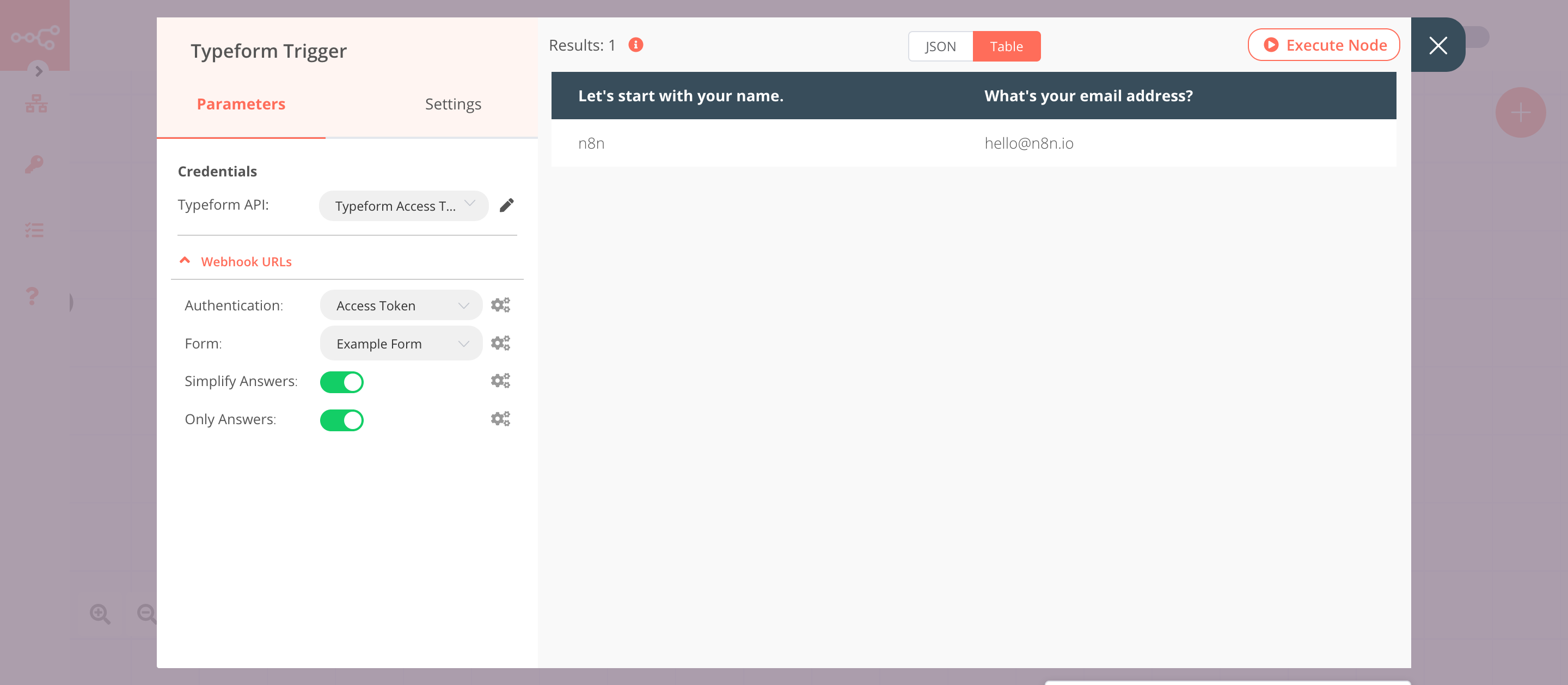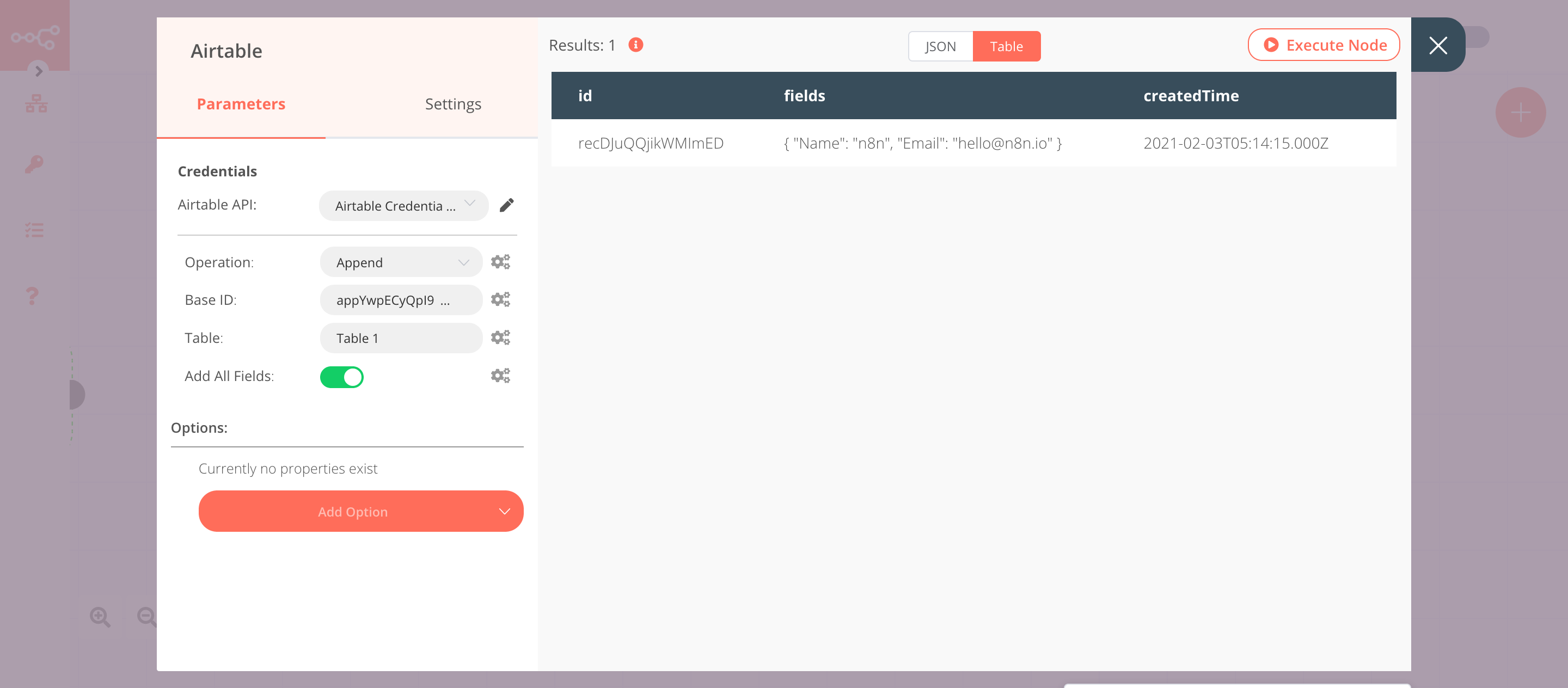Typeform Trigger#
Typeform is an online software as a service company that specializes in online form building and online surveys. Its main software creates dynamic forms based on user needs.
Credentials
You can find authentication information for this node here.
Example Usage#
This workflow allows you to store the response of a form submission to Airtable and send a message to a channel on Slack. You can also find the workflow on the website. This example usage workflow would use the following nodes.
The final workflow should look like the following image.

1. Typeform Trigger node#
This node will trigger the workflow when a form response is submitted.
This example workflow uses a Typeform to collect name and email address. Create a form exactly like this for the example workflow. Here are the questions and their question types for the form.
| Question | Type |
|---|---|
| Let's start with your name. | Short Text |
| What's your email address? |
- First of all, you'll have to enter credentials for the Typeform Trigger node. You can find out how to do that here.
- Select your form from the Form dropdown list.
- Click on Execute Node to run the workflow.
In the screenshot below, you will notice that the Typeform Trigger node triggers the workflow and returns the response submitted by a user.

2. Set node#
We will use the Set node to ensure that only the data that we set in this node gets passed on to the next nodes in the workflow. We will set the value of Name and Email in this node.
- Click on Add Value and select 'String' from the dropdown list.
- Enter
Namein the Name field. - Click on the gears icon next to the Value field and click on Add Expression.
- Select the following in the Variable Selector section: Current Node > Input Data > JSON > Let's start with your name.. You can also add the following expression:
{{$json["Let's start with your name."]}}. - Click on Add Value and select 'String' from the dropdown list.
- Enter
Emailin the Name field. - Click on the gears icon next to the Value field and click on Add Expression.
- Select the following in the Variable Selector section: Current Node > Input Data > JSON > What's your email address?. You can also add the following expression:
{{$json["What's your email address?"]}}. - Toggle Keep Only Set to
true. We set this option to true to ensure that only the data that we have set in this node get passed on to the next nodes in the workflow. - Click on Execute Node to run the node.
In the screenshot below, you will notice that the node sets the values of Name and Email. These values are passed to the next node in the workflow.

3. Airtable node (Append)#
This node will append the data that we set in the previous node to a table. Create a table like this in your Airtable base.
- First of all, you'll have to enter credentials for the Airtable node. You can find out how to do that here.
- Select 'Append' from the Operation dropdown list.
- Enter the Base ID in the Base ID field. For obtaining the Base ID, head over to their API page and select the correct base. You'll find the Base ID there.
- Enter the name of your table in the Table field.
- Click on Execute Node to run the node.
In the screenshot below, you will notice that the node appends the data that we had set in the previous node.

4. Slack node (post: message)#
This node will send a message about the new form submission to a channel in a Slack workspace.
- First of all, you'll have to enter credentials for the Slack node. You can find out how to do that here.
- Enter the name of a channel in the Channel field.
- Click on the gears icon next to the Text field and click on Add Expression.
- Enter the following text in the Expression Editor
1 2 3
*New Submission* Name: {{$node["Set"].json["Name"]}} Email: {{$node["Set"].json["Email"]}} - Click on Execute Node to run the node.
In the screenshot below, you will notice that the node sends a message with the new form response on Slack.

Activate workflow for production
You'll need to save the workflow and then click on the Activate toggle on the top right of the screen to activate the workflow. Your workflow will then be triggered as specified by the settings in the Typeform Trigger node.